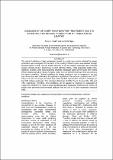| dc.description.abstract | The extent of pollution of dairy wastewater treated in a septic tank and its potential for biogas production was investigated. Performance of the existing treatment system was assessed through characterization of both raw and treated effluents. From the analysis parameters likeChemical Oxygen Demand (COD), Biochemical Oxygen Demand (BOD5), Total Suspended Solids (TSS), alkalinity, turbidity, color and phosphorus disclosed inadequate system performance with treated effluent displaying higher values of organic matter than the allowed discharge limits according to the national standards. Optimal conditions for biogas production such as temperature, pH and type of inoculum were determined through batch experiments. The optimum conditions were 35 oC and pH 7.0 with cow dung as inoculum type, which resulted in production of 0.49 m3 of biogas per Kg COD of dairy wastewater. The reduction efficiencies of COD, TS and VS were 98%, 78% and 73%, respectively. Therefore, these conditions can be applied for treatment of wastewater at Tanga fresh limited (TFL) Plant, to ensuring adequate dairy wastewater treatment and recovery of biogas while preventing environmental pollution from the 100 m3 of dairy wastewater produced daily. | en_US |

